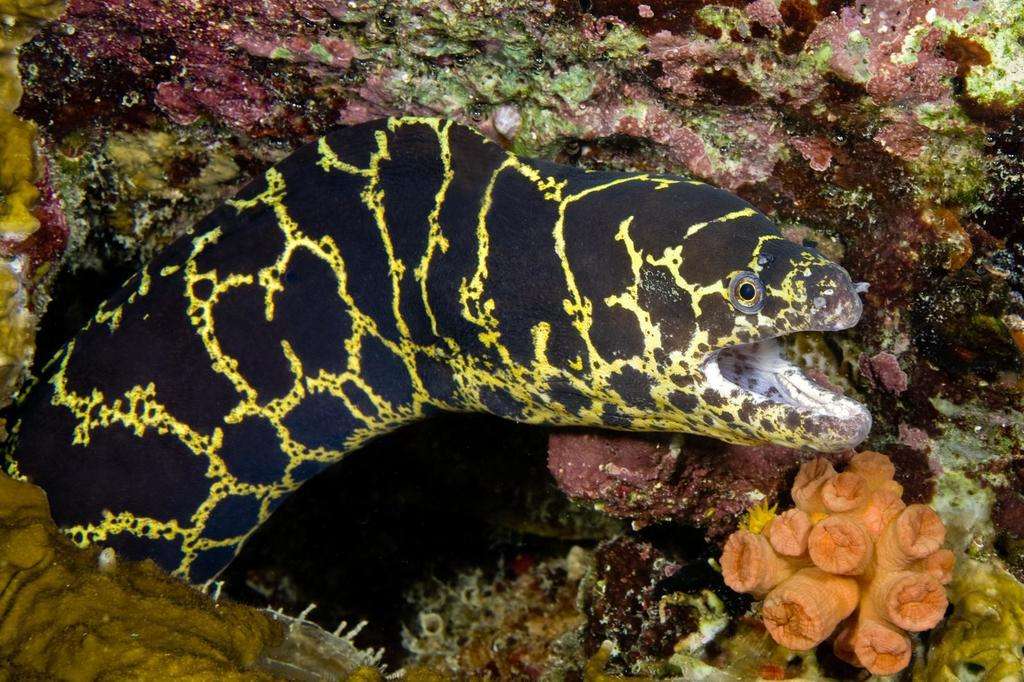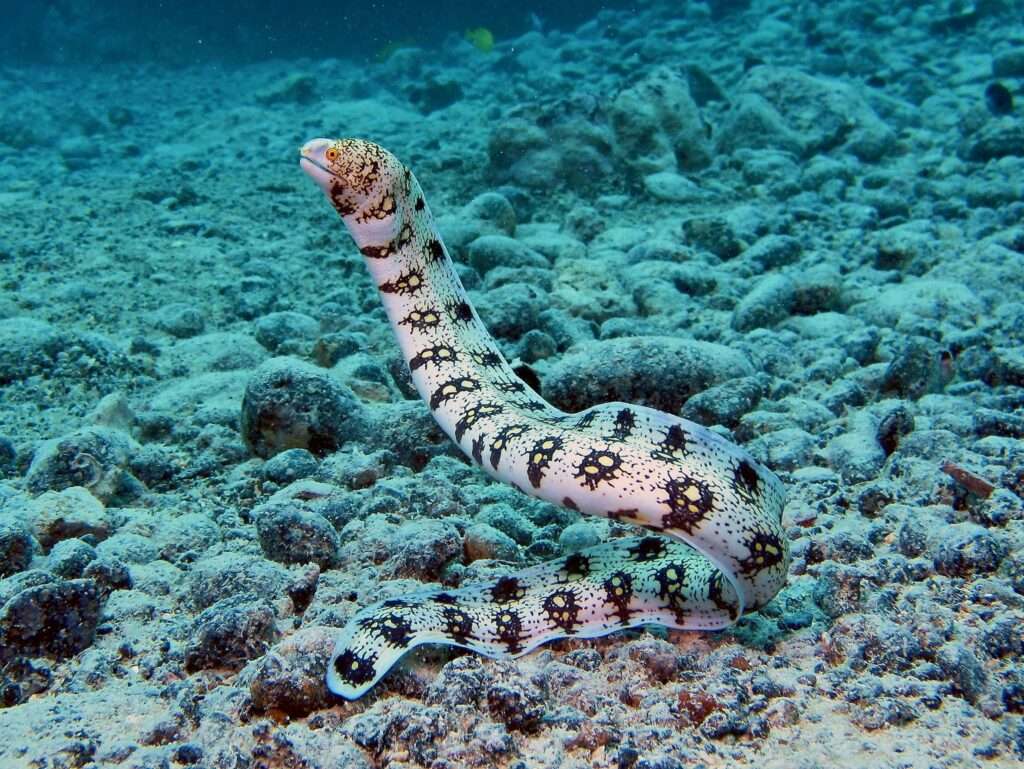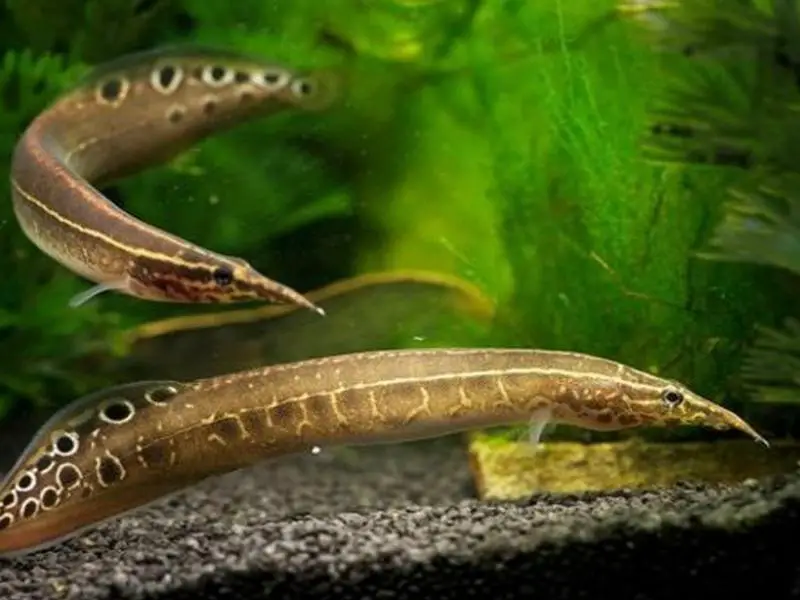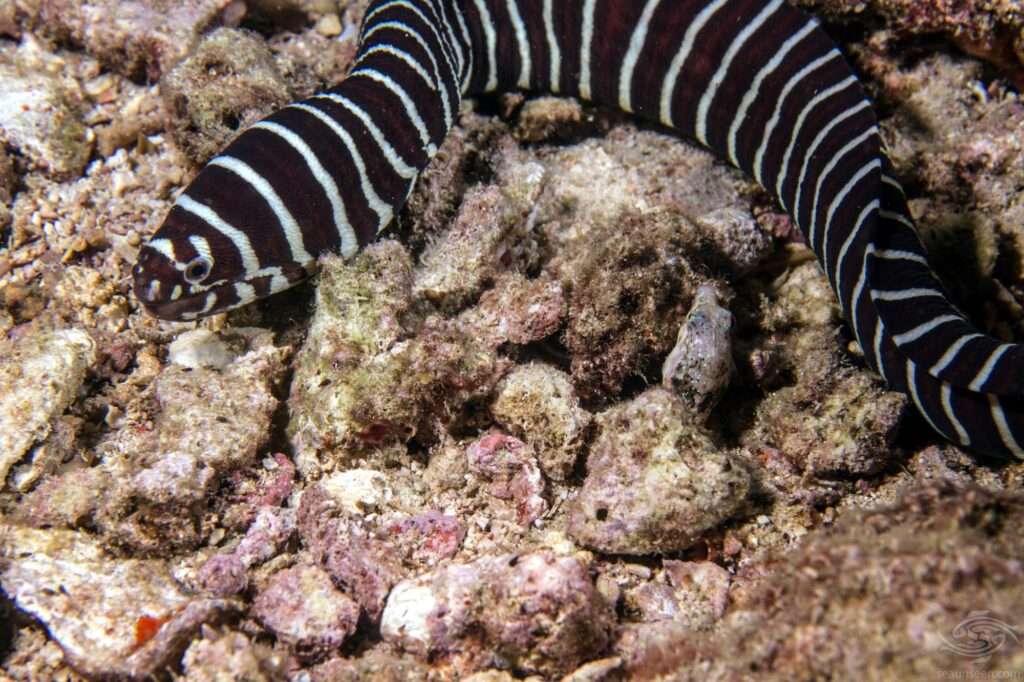
The body of a chain moray eel is white to yellow with black, brown, or gray mottling. Adult eels have more marks than juveniles do, and each eel has a different pattern. One continuous dorsal fin and one continuous pelvic fin are features of the Chain Moray. They have flexible gill coverings, no scales, and taste receptors on their nose and mouth. The teeth of the Chain Moray are formed like blunt molars and are used to masticate crustaceans. With two holes at the top of their heads and two tube-like appendages on their noses, they have an exceptional sense of smell. Their undersized eyes and poor vision are compensated for by this incredible talent.
Although certain Chain Moray Eels have been observed to grow larger in captivity, they are crustacean eaters with shorter heads and mouths that can reach lengths of 28″ (71 cm). Since novices frequently do not have extremely large tanks and since this eel’s long-term survival depends on live foods, intermediate aquarists can keep chain moray eels.
All morays have the potential to appear quite cruel merely by breathing normally. By opening and closing their lips, they are only sucking water out of their gils and down their throats. A crab that is two to three times the breadth of the eel’s head takes the Chain Moray anything from 1.5 to 4 minutes to break up and consume!
While little crabs are consumed whole, larger ones are broken up into smaller bits by turning, tugging, knotting, and thrashing them. Other fish frequently pursue morays while they hunt. Those perceptive fish are aware that the eel will reveal fish that are lurking in the reef. Those fish are typically goatfish, soapfish, lionfish, or groupers. Although morays are quite resilient, the Chain Moray presents a long-term difficulty.
Traits
Chain morays, also known as small banded eels, are normally between a few centimeters to 70 cm in length. Their body is long and heavy, resembling a snake, and they lack ventral and pectoral fins. The anal, dorsal, and tail fins come together to form a continuous fin that starts behind the head, extends halfway to the abdomen, and encompasses the tail. Its eyes are either above or just below its mid-jaw, and its head has a short, steep profile with a short, rounded snout. The entire body is protected by a transparent mucus covering rather than scales. Chain morays are dark brown to black in color, with asymmetrical, chain-like markings on their body and yellow eyes. These brilliant yellow marks, which resemble chains, are connectable. They have small, strong jaws because they are carnivorous, but unlike other eels, they have short, blunt teeth, some of which are molariform.
Habitat
Chain morays are solitary creatures that live in the shallow waters of coral reefs, the sand, and along rocky shorelines. They can occasionally be seen in tide pools as well. Although the strong fragrance of a particular prey may occasionally lure them to feed during the day, they demonstrate a predatory function and hunt for prey primarily at night. Instead of actively hunting, they usually wait for prey to approach within a short distance of their holes before striking. It is normal to see chain morays’ heads sticking out of the reef during the day. However, if they are actively hunting at night, they may graze elsewhere. It can be found all across the Caribbean Sea, including the Bahamas, from Florida to the Gulf of Mexico and the Florida Keys, the western Atlantic from Bermuda, and other locations. Along the coast of South America, from southern Brazil to Tuxpan and Veracruz in Mexico, to northwest Cuba, it can also be found. Ascension Island has a presence, while the eastern Atlantic does not. It is indigenous to practically all of the Caribbean nations, including Curacao, Suriname, Trinidad and Tobago, and many others.
Keeping as Pet

Food
The food of chain moray eels, which consists of a variety of crustaceans, tiny fish, shrimp, and octopi, is well suited to them. Particularly for crustaceans, the small, rounded, and blunt teeth of chain morays make this possible. Additionally, they have short, strong jaws that allow them to completely seal their mouths and smash prey. They eat a variety of shrimp species like Lysmata moorei as well as crab species like Cronius tumidulus and Acanthonyx petiverii. They actively seek for food primarily at night using their smell senses, although they may hunt passively if a prey animal is nearby. They have a very distinctive feeding pattern termed rotational feeding, and throughout this pattern, they engage in a feeding habit known as “knotting.”
Rotational eating is essentially the process by which an organism spins on its longitudinal axis to consume enormous prey. The term “knotting” refers to a series of intricate motions that include putting the tail under the centre of the animal’s body in a backward motion, followed by passing the tail back up and into the first loop to form a second loop. The prey is subsequently decapitated, mostly torn apart, or swallowed when the two loops are tightened and the eel drags its head backward through the loops.
Aquarium for Chain Moray
15–20% of medium-sized tanks up to 90 gallons each week. Once the water is steady and matured, large tanks larger than 100 gallons can have 15% to 20% of their water changed weekly, depending on the bioload. The rock work should be substantial and rest firmly on the tank’s glass bottom. To prevent the Chain Moray Eel’s clumsy movements from toppling the rock work and injuring itself, non-toxic zip ties can be used to hold the pieces of rock together. Create at least one or two caves or deep fissures where the eel can fully bury his body. These hiding places must be entirely dark inside.
Since these eels are powerful and can push lids open, a very tight fitting lid that is secured with hefty weights or extremely strong clips is required; deeper tanks are preferable. Make sure any openings in the lid’s surface are sufficiently small to keep the eel from escaping. Since they like to dig, sand is the greatest substrate. Do not use decorations made of fiberglass, even if they are 3″ around and 2 feet long. Juveniles can live in tanks that are smaller, averaging 50 gallons per 12″ or 1 foot.
Table





